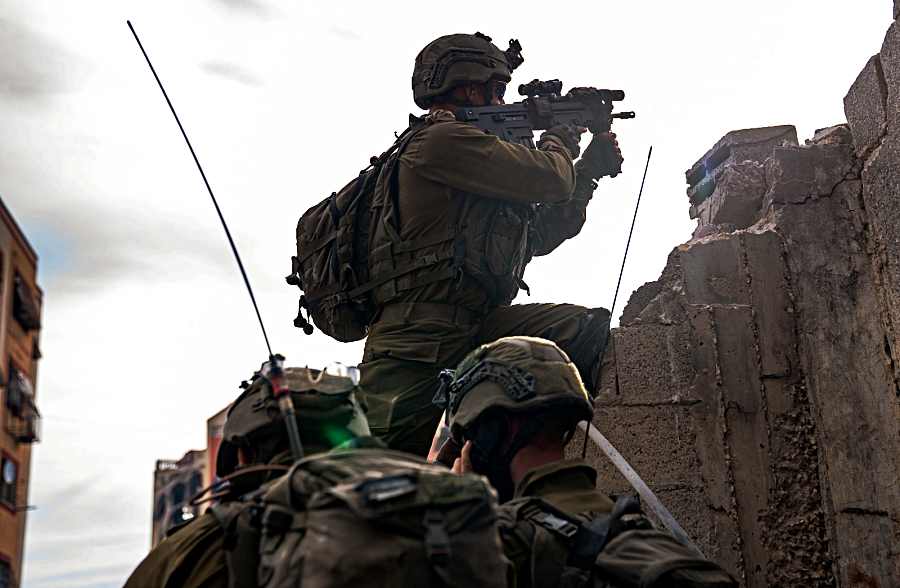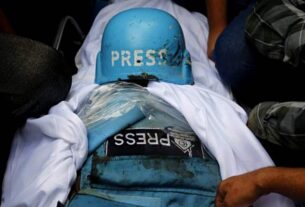Sun 10 December 2023:
In the week that followed the expiration of the “humanitarian pause”, Israel has escalated its invasion of the Gaza Strip. Aerial bombardment by the Israeli Air Force (IAF) resumed within minutes of the uneasy week-long pause that ended on December 1. It was then followed by advances of armoured units, artillery and infantry on the ground.
During the truce, Israeli forces continued issuing warnings and threats aimed mainly at Hamas but also at the Palestinian population. Once the truce was over, Israel showed it meant what it had said, making a strong and determined push into the south of the strip, mainly targeting the city of Khan Younis.
Many analysts had expected that they would advance further towards the urban centre of Gaza City, with the three columns that carried out the invasion along different axes converging towards the old city.
Instead, Israeli forces decided to open a new front by advancing into the southern part of Gaza. In a fashion similar to their assault on Gaza City in November, they again chose to encircle the city before taking the battle to the next stage.
North of the city of Khan Younis two columns of armour, artillery and mechanised infantry advanced westwards from Israel, towards the sea. But rather than pushing all the way to the shore, they stopped two kilometres (1.2 miles) short of the beaches and sent troops in each others’ direction down Salah al-Din Road, the main artery running along the entire Gaza Strip from north to south. When Israeli battalions met halfway through, they completed the encirclement of the area of Jarara up to the Israeli boundary.
Why Israel chose to keep significant forces engaged in blocking this small piece of territory, farmland and suburbia of seemingly insignificant defence value, rather than attempt to take it, is unclear.
An additional column was then sent from Israel towards the centre of Khan Younis from the east, while Israeli tanks and mechanised infantry seemed to be slowly pushing simultaneously down Salah al-Din Road towards the urban centre.
In preparation for the action in the southern section of Gaza, Israel issued a map dividing the whole of the besieged territory into 623 blocks of varying sizes. It then started issuing orders to Palestinians to evacuate those blocks where it would conduct military operations. Israel announced that this approach, “based on sophisticated mapping software”, was to keep civilians safe from military operations, partly to satisfy the demand by the United States to reduce civilian casualties.
Alas, this was nothing but a public relations operation. Israeli authorities are fully aware that the south is swollen with refugees from Gaza City and other areas evacuated either by direct orders of the occupiers, or from fear of being caught in the deadly fighting. Most of the nearly two million inhabitants of the area not larger than 200sq km (77sq miles) live in makeshift conditions, with only intermittent electricity and little access to any media or the internet — so there is little chance that they could react to short notice orders to evacuate. Aerial bombardment continues unabated, and the number of civilian casualties remains high, with more than 17,000 people killed, including more than 7,000 children.
These figures lie in high disproportion to the 93 Israelis killed in Gaza so far, all members of the military.
Global cries to stop the fighting in Gaza are increasing and even the US, despite its hand-in-glove relationship with Israel, is obviously getting uncomfortable. In the United Nations Security Council, it vetoed a call for a humanitarian ceasefire, but with even traditional ally United Kingdom abstaining, and all remaining 13 members in favour of ending the war, Washington no doubt realises that demands to end the plight of civilians will only increase.
Israel is trying to fend off accusations of indiscriminately killing civilians, but its claims make little sense. Earlier this week at a briefing in Israel, an official said that a Hamas fighter was killed for every two civilians, suggesting that this was a better combatant-to-civilian kill ratio than most armies in recent wars.
Even putting cynicism aside, the maths in this claim leads to scepticism. With nearly 17,400 people dead, it would imply that Hamas has suffered 5,800 combat deaths, a ratio of more than 62 killed for each Israeli soldier lost in battle.
Even allowing for a hypothetical and highly unrealistic possibility that half of them were killed while out of combat, in bed or in the streets, it would still mean that the Israeli military killed 2,900 enemies while suffering only 93 deaths in action.
In military terms, the ratio of more than 31 enemy soldiers killed for one combat death indicates a significant defeat, a rout even. It’s a militarily and psychologically untenable situation for the losing side.
To be sure, a military formation can lose 30 soldiers in a battle where just one enemy dies; usually, that battle is lost but not necessarily the war.
But for almost any military a constant loss ratio of greater than 30:1 in operations that last more than a month on at least two distinct, if connected, battlefields — in north and south Gaza — would be a sure sign of an imminent total collapse.
Even allowing for the high motivation of ideologically recruited Hamas fighters, it would still be hard to imagine that they would continue fighting after such losses.
“I see the signs that indicate [Hamas] is beginning to break in Gaza,” Israeli Defence Minister Yoav Gallant told troops he was visiting on Friday.
Gallant’s claim was either an exaggeration or an optimistic attempt to boost his soldiers’ morale. In reality, it is obvious that Hamas fights on — in a way that would not be possible if it were losing as many fighters as Israel claims to be killing.

______________________________________________________________
FOLLOW INDEPENDENT PRESS:
WhatsApp CHANNEL
https://whatsapp.com/channel/0029VaAtNxX8fewmiFmN7N22
![]()
TWITTER (CLICK HERE)
https://twitter.com/IpIndependent
FACEBOOK (CLICK HERE)
https://web.facebook.com/ipindependent
Think your friends would be interested? Share this story!





